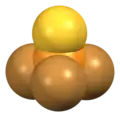| |||
| Names | |||
|---|---|---|---|
| Other names
Thiophosphoryl tribromide Phosphorus thiobromide Phosphorothioic tribromide | |||
| Identifiers | |||
3D model (JSmol) |
|||
| ChemSpider | |||
| ECHA InfoCard | 100.021.367 | ||
| EC Number |
| ||
PubChem CID |
|||
CompTox Dashboard (EPA) |
|||
| |||
| |||
| Properties | |||
| PSBr3 | |||
| Molar mass | 302.75 g·mol−1 | ||
| Appearance | yellow crystals[1][2] | ||
| Density | 2.85 g cm−3[2] | ||
| Melting point | 37.8 °C (100.0 °F; 310.9 K) | ||
| Boiling point | 212 °C (414 °F; 485 K) decomposes[2] | ||
| Structure[3] | |||
| Cubic | |||
| Pa3, No. 205 | |||
a = 11.03 Å, b = 11.03 Å, c = 11.03 Å | |||
| Tetrahedral at the P atom | |||
| Related compounds | |||
Related compounds |
|||
Except where otherwise noted, data are given for materials in their standard state (at 25 °C [77 °F], 100 kPa).
Infobox references | |||
Thiophosphoryl bromide is an inorganic compound with the formula PSBr3.[1]
Preparation
Thiophosphoryl bromide can be prepared by heating phosphorus tribromide with phosphorus pentasulfide, or with elemental sulfur in an inert atmosphere at 130 °C.[4]
Thiophosphoryl bromide is one product of the bromination of P4S7 in cold carbon disulfide:[1]
Structure and properties
Thiophosphoryl bromide has tetrahedral molecular geometry and C3v molecular symmetry. According to gas electron diffraction, the phosphorus–sulfur bond length is 1.895 Å and the phosphorus–bromine bond length is 2.193 Å, while the S=P−Br bond angle is 116.2° and the Br−P−Br bond angle is 101.9°.[5]
Thiophosphoryl bromide is soluble in carbon disulfide, chloroform and diethyl ether.[4]
Reactions
Like other phosphoryl and thiophosphoryl halides,[1] thiophosphoryl bromide readily hydrolyses, undergoes nucleophilic substitution and forms adducts with Lewis acids.[6] Reaction with lithium iodide generates the mixed thiophosphoryl halides PSBr2I and PSBrI2 but not thiophosphoryl iodide, PSI3.[7] Thiophosphoryl bromide is of use in organic synthesis for reducing sulfoxides to thioethers,[8] and sulfines to thioketones.[9]
References
- 1 2 3 4 Greenwood, Norman N.; Earnshaw, Alan (1997). Chemistry of the Elements (2nd ed.). Butterworth-Heinemann. pp. 501–503. ISBN 978-0-08-037941-8.
- 1 2 3 William M. Haynes, ed. (2016). CRC Handbook of Chemistry and Physics (97th ed.). CRC Press. p. 4-78. ISBN 978-1498754293.
- ↑ "ICSD Entry: 39130". Cambridge Structural Database: Access Structures. Cambridge Crystallographic Data Centre. Retrieved 2022-10-30.
- 1 2 Arthur D. F. Toy (1975). The Chemistry of Phosphorus. Permanon Texts in Inorganic Chemistry. Vol. 3. Permanon Press. p. 438. ISBN 9781483139593.
- ↑ Jacob, E. Jean; Danielson, Donald D.; Samdal, Svein (1980). "An electron diffraction determination of the molecular structures of phosphoryl bromide and thiophosphoryl bromide". J. Mol. Struct. 62 (2): 143–155. Bibcode:1980JMoSt..62..143J. doi:10.1016/0022-2860(80)85232-X.
- ↑ van der Veer, W.; Jellinek, F. (1970). "Adducts of thiophosphoryl compounds with metal halides. Part III: Addition compounds of phosphoryl bromide and thiophosphoryl bromide". Recl. Trav. Chim. Pays-Bas. 89 (8): 833–844. doi:10.1002/recl.19700890809.
- ↑ Dillon, K. B.; Craveirinha Dillon, M. G.; Waddington, T. C. (1977). "The identification of some new thiophosphoryl compounds containing P–I bonds by means of 31P N.M.R. spectroscopy". Inorg. Nucl. Chem. Lett. 13 (8): 349–353. doi:10.1016/0020-1650(77)80109-8.
- ↑ Still, I. W. J.; Reed, J. N.; Turnbull, K. (1979). "Thiophosphoryl bromide: a new reagent for the reduction of sulfoxides to sulfides". Tetrahedron Lett. 20 (17): 1481–1484. doi:10.1016/S0040-4039(01)86183-9.
- ↑ Kuipers, J. A. M.; Lammerink, B. H. M.; Still, I . W. J.; Zwanenburg, B. (1981). "Phosphorus Pentasulfide and Thiophosphoryl Bromide: Facile Reagents for the Reduction of Sulfines to Thiones". Synthesis. 1981 (4): 295–297. doi:10.1055/s-1981-29423.

